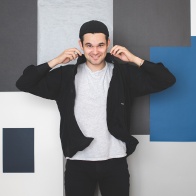What it does
Children grow 7 sizes in their first 2 years on Earth and this equates to a lot of wasted clothing. Petit Pli’s versatile waterproof shells are pleated in such a way that they can grow bi-directionally to custom fit a large range of sizes.
Your inspiration
I wanted enter the world of fashion, but soon became disheartened by the unsustainable means by which it operates. I mapped out and researched the entire industry from farming cotton crops, to distribution channels and even the operation of trend analysis (and influencing) companies. Around the same time, my sister was having another child. The engineer in me realised that if I simplified the huge problem I was trying to tackle, I’d have a chance at actually making a difference to fashion consumption. That’s when I focussed on a niche user group, children, and the concept of one size fits all began to surface.
How it works
The concept of Petit Pli is built upon using materials resourcefully, because the garments grow up to 7 sizes, parents are buying one, not seven different garments. This all amounts to less: material waste at production; labour; transportation (CO2 emissions) and waste at end of life. Petit Pli also hopes to work on a psychological level, instilling slow-fashion values in growing children and new parents who are both at a new stage of life where they are open to learning. An auxetic structure has been embedded in Petit Pli fabrics, giving the clothing a negative Poisson’s ratio. Ergonomic data of children have been studied to design a structure that retains a defined silhouette at different stages of expansion, whilst simultaneously custom fitting children of a wide age range. The expanded shape is directly determined by the packing ratios of the material structure.
Design process
Having simplified the problem to childrenswear & come up with the concept of one size fits all, I looked for a solution of a high technology readiness level; why? Because it would have to compete with the cost of clothes, be scalable, desirable and actually come to market to have any real-world effect. Pleating was an effective solution. The first prototype was a pair of trousers I had sewn together and cooked in my oven at home, they fit onto my new-born nephew & my 2-year-old niece. The rough prototype helped to clearly communicate the idea to parents. I interned at Ciment pleating, where I used videography as a research tool and built a strong understanding of the underlying mechanics. I was also able to conduct my own experiments of embedding structures into fabrics and began creating the auxetic fabric; many variables affected the outcome. I found myself designing for two different users, parents and young children. Both of which I am not. User-centric design was imperative to develop the proposal, so I manufactured prototypes and delivered them for testing. This was truly valuable to the outcome of Petit Pli, resulting features include a pack away pocket and the structure pointing down like roofing tiles to avoid the collection of crumbs and spilled liquids.
How it is different
Patent pending, Petit Pli was inspired by my research into deployable satellite panels. Petit Pli expands in an orchestrated event; I’ve studied various ergonomic data of children to come up with a structure that retains a defined silhouette at different stages of expansion, whilst simultaneously custom fitting children from 4 to 36 months. Petit Pli is designed from the ground up for children, it is not miniaturised adult clothing. The technical outerwear garments are machine washable, packable, always fit, and are rain & wind proof, giving unrivalled versatility to both parent & child. Current synthetic outerwear is bulky, restrictive and wasteful. Petit Pli is designed to be a superior product both in terms of performance & sustainability. The pleat system offers unparalleled agility, with the garment adapting in synchrony with the motion of a child; it offers a cost effective solution to parents whilst reducing their impact on the environment.
Future plans
With the invention patent pending, I hope to raise the funds to take this product, and a wider range that are still in development, to market. Part of that journey will involve even more durability testing, collaborating with fashion designers, sourcing manufacturers with high ethical standards, and continuing to build a community willing to help Petit Pli in its quest. I have other ideas that I’d love to explore in more depth and I aim to be a leader in the field of technical garments; pushing the ability of humanity through their second skin, whilst retaining ethical considerations and reducing the negative impacts of the fashion industry.



Connect